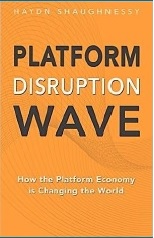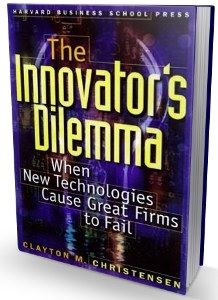There’s a world of difference between innovation and disruption.
“Think of innovation as doing more, in the same old way,” said Haydn Shaughnessy, innovation specialist and author of Platform Disruption Wave: How the Platform Economy is Changing the World. He presented a GARP webinar on “The Rise of Mega-Platforms and the Risks to Banking” on May 25, 2016. In the first part of his talk, he described mega-platforms.
 He referred to the thesis of The Innovator’s Dilemma: When New Technologies Cause Great Firms to Fail by Clayton Christensen. This book argues that successful companies get so caught up in meeting the needs of current customers that they do not look ahead to what the next disruptive innovation might be.
He referred to the thesis of The Innovator’s Dilemma: When New Technologies Cause Great Firms to Fail by Clayton Christensen. This book argues that successful companies get so caught up in meeting the needs of current customers that they do not look ahead to what the next disruptive innovation might be.
To get a better idea of the disruption that will be caused by mega-platforms, “look at how industries disaggregate,” Shaughnessy suggested. The phases of the IT industry provide a useful model for the financial services industry. The time frame is different; IT is currently in phase six. However, banking in 2016 is in phase two, the “experimental” phase, which IT went through in the years 1998 to 2005.
During the experimental phase, Shaughnessy predicts that much of FinTech will fail or be re-organized as the industry tries to find its way. Nothing is left unchallenged during a time of disruption. Even the biggest player in an industry might be toppled. “Nokia was an incumbent that was forced to seek a new franchise,” he noted, referring to the cell phone giant that had to adapt to the demand for new and different smart phones.
The wave of change will be significant, said Shaughnessy. China has scale advantage. Transaction businesses must figure out what to do. In China, the cross-border e-commerce was $1 trillion per annum in 2016 and is experiencing a 30 percent compound annual growth rate.
Once the dust has settled, he predicted that 10 to 15 mega-platforms will dominate global trade, “and these will be bigger and more powerful than you can imagine.”
The mega-platforms mean new systemic risk factors. “There will be bank-free zones on platforms,” he said. “If banks get a chance to provide liquidity, it will be algorithmic.” The price for financial services will trend toward zero.
Shaughnessy touched on some current solutions. “There will be an opportunistic approach to Fintech.” He said there will be interest in banking as a platform.
Additionally, interest in the distributed database called blockchain is rising because this will be able to serve as the public ledger of transactions. Replying to a question from the audience, Shaughnessy said he thought blockchain “will be most effective in post-trade settlement.”
The audience had many questions. Financial institutions are constantly preparing for many small changes but may not be well prepared for disruption on the scale that he predicts. In big bold letters, Shaughnessy ended with a warning: Banks risk letting mega-platforms dictate the future of finance. ª
Click here to go to part one of the presentation.

